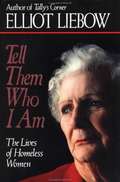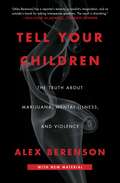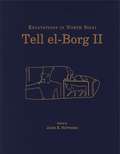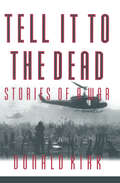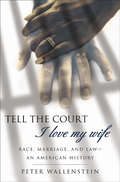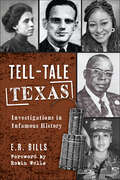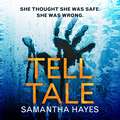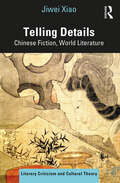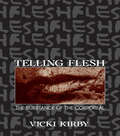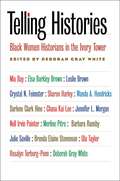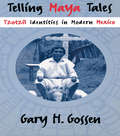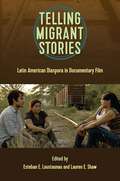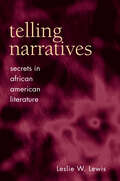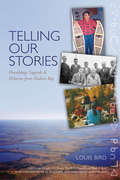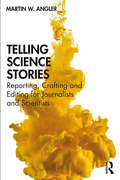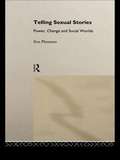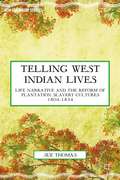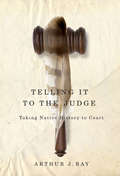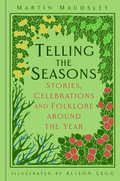- Table View
- List View
Tell Them Who I Am: The Lives of Homeless Wome
by Elliot LiebowLiebow observes them, creating portraits that are intimate and objective, while breaking down stereotypes and dehumanizing labels often used to describe the homeless. Liebow writes about their daily habits, constant struggles, their humor, compassion and strength.-- National syndicated radio interview.
Tell Your Children: The Truth About Marijuana, Mental Illness, and Violence
by Alex BerensonAn eye-opening report from an award-winning author and former New York Times reporter reveals the link between teenage marijuana use and mental illness, and a hidden epidemic of violence caused by the drug—facts the media have ignored as the United States rushes to legalize cannabis.Recreational marijuana is now legal in nine states. Almost all Americans believe the drug should be legal for medical use. Advocates argue cannabis can help everyone from veterans to cancer sufferers. But legalization has been built on myths– that marijuana arrests fill prisons; that most doctors want to use cannabis as medicine; that it can somehow stem the opiate epidemic; that it is not just harmless but beneficial for mental health. In this meticulously reported book, Alex Berenson, a former New York Times reporter, explodes those myths: • Almost no one is in prison for marijuana; • A tiny fraction of doctors write most authorizations for medical marijuana, mostly for people who have already used; • Marijuana use is linked to opiate and cocaine use. Since 2008, the US and Canada have seen soaring marijuana use and an opiate epidemic. Britain has falling marijuana use and no epidemic; • Most of all, THC—the chemical in marijuana responsible for the drug’s high—can cause psychotic episodes. After decades of studies, scientists no longer seriously debate if marijuana causes psychosis. Psychosis brings violence, and cannabis-linked violence is spreading. In the four states that first legalized, murders have risen 25 percent since legalization, even more than the recent national increase. In Uruguay, which allowed retail sales in July 2017, murders have soared this year. Berenson’s reporting ranges from the London institute that is home to the scientists who helped prove the cannabis-psychosis link to the Colorado prison where a man now serves a thirty-year sentence after eating a THC-laced candy bar and killing his wife. He sticks to the facts, and they are devastating. With the US already gripped by one drug epidemic, this book will make readers reconsider if marijuana use is worth the risk.
Tell el-Borg II: Excavations in North Sinai
by James K. HoffmeierThis is the second and final volume of scientific and interdisciplinary reports on the excavations and research conducted at Tell el-Borg, north Sinai, between 1998 and 2008, written by the scholars and specialists who worked on the site under the direction of Professor James K. Hoffmeier.This volume focuses on the cemetery areas, which yield more than a dozen tombs, typically made of mud brick, some of which were constructed for a single occupant and some of which were larger tombs that accommodated multiple family members. Included is a treatment of an area of “public” space featuring a temple and a well, among other things, and a study of the geological results of the nearby ancient Ballah Lakes that offers new data on the history of the Nile distributary that flowed by Tell el-Borg. The balance of the work deals with specialty reports, including the faunal and botanical remains, the clay coffins, and elite stones. A concluding chapter offers a synthesis of the decade of work and ties together the finds published in both volumes.In addition to the editor, the contributors to this volume include Stephen Moshier, Bahaa Gayed, Gregory D. Mumford, Scott D. Haddow, Mark Janzen, Thomas W. Davis, Rexine Hummel, Hesham M. Hussein, Carole McCartney, Michelle A. Loyet, Louise Bertini, and Salima Ikram.
Tell el-Borg II: Excavations in North Sinai
by James K. HoffmeierThis is the second and final volume of scientific and interdisciplinary reports on the excavations and research conducted at Tell el-Borg, north Sinai, between 1998 and 2008, written by the scholars and specialists who worked on the site under the direction of Professor James K. Hoffmeier.This volume focuses on the cemetery areas, which yield more than a dozen tombs, typically made of mud brick, some of which were constructed for a single occupant and some of which were larger tombs that accommodated multiple family members. Included is a treatment of an area of “public” space featuring a temple and a well, among other things, and a study of the geological results of the nearby ancient Ballah Lakes that offers new data on the history of the Nile distributary that flowed by Tell el-Borg. The balance of the work deals with specialty reports, including the faunal and botanical remains, the clay coffins, and elite stones. A concluding chapter offers a synthesis of the decade of work and ties together the finds published in both volumes.In addition to the editor, the contributors to this volume include Stephen Moshier, Bahaa Gayed, Gregory D. Mumford, Scott D. Haddow, Mark Janzen, Thomas W. Davis, Rexine Hummel, Hesham M. Hussein, Carole McCartney, Michelle A. Loyet, Louise Bertini, and Salima Ikram.
Tell it to the Dead: Memories of a War
by Donald KirkThis work reports on the Vietnam war as seen by the GI in the jungles. It discusses current attitudes, views from Saigon, Hanoi and Phnom Penh, and other locales in the countryside.
Tell the Court I Love My Wife
by Peter WallensteinThe first in-depth history of miscegenation law in the United States, this book illustrates in vivid detail how states, communities, and the courts have defined and regulated mixed-race marriage from the colonial period to the present. Combining a storyteller's detail with a historian's analysis, Peter Wallenstein brings the sagas of Richard and Mildred Loving and countless other interracial couples before them to light in this harrowing history of how individual states had the power to regulate one of the most private aspects of life: marriage.
Tell the Truth & Shame the Devil: The Life, Legacy, and Love of My Son Michael Brown
by Lyah Beth Leflore Lezley McspaddenThe revelatory memoir of Lezley McSpadden--the mother of Michael Brown, the African-American teenager killed by the police officer Darren Wilson in Ferguson, Missouri on August 9, 2014--sheds light on one of the landmark events in recent history. "I wasn't there when Mike Mike was shot. I didn't see him fall or take his last breath, but as his mother, I do know one thing better than anyone, and that's how to tell my son's story, and the journey we shared together as mother and son." --Lezley McSpadden When Michael Orlandus Darrion Brown was born, he was adored and doted on by his aunts, uncles, grandparents, his father, and most of all by his sixteen-year-old mother, who nicknamed him Mike Mike. McSpadden never imagined that her son's name would inspire the resounding chants of protesters in Ferguson, Missouri, and ignite the global conversation about the disparities in the American policing system. In Tell the Truth & Shame the Devil, McSpadden picks up the pieces of the tragedy that shook her life and the country to their core and reveals the unforgettable story of her life, her son, and their truth. Tell the Truth & Shame the Devil is a riveting family memoir about the journey of a young woman, triumphing over insurmountable obstacles, and learning to become a good mother. With brutal honesty, McSpadden brings us inside her experiences being raised by a hardworking, single mother; her pregnancy at age fifteen and the painful subsequent decision to drop out of school to support her son; how she survived domestic abuse; and her unwavering commitment to raising four strong and healthy children, even if it meant doing so on her own. McSpadden writes passionately about the hours, days, and months after her son was shot to death by Officer Darren Wilson, recounting her time on the ground with peaceful protestors, how she was treated by police and city officials, and how she felt in the gut-wrenching moment when the grand jury announced it would not indict the man who had killed her son. After the system failed to deliver justice to Michael Brown, McSpadden and thousands of others across America took it upon themselves to carry on his legacy in the fight against injustice and racism. Tell the Truth & Shame the Devil is a portrait of our time, an urgent call to action, and a moving testament to the undying bond between mothers and sons.
Tell-Tale Texas: Investigations in Infamous History (The History Press)
by E.R. BillsUncover the suppressed testimony of the Lone Star State's uncomfortable past.Tinseltown almost always gets Texas wrong. The "Searchers" never did that much searching, the "Giants" were hardly ever big in terms of character and The Last Picture Show was just the beginning of a disturbing reveal. As acclaimed writer Stephen Harrigan suggests, the Lone Star State was not exactly a Big, Wonderful Thing, and for too many Texans, nothing was ever "Awright, Awright, Awright." A Black civil rights champion was assassinated in 1976, and the incident was buried. A "Cowtown Catcher in the Rye" was published in 1940, and the country club set made it disappear. And the war machines of Hitler and Mussolini were perfected with Texas oil during the Spanish Civil War. Author E.R. Bills challenges his proud neighbors, earnestly asking them to take a hard look at their past and examine their own historical amnesia, cultural fragility and fierce denial.
Tell-Tale: A heartstopping psychological thriller with a jaw-dropping twist
by Samantha HayesA woman stands on a bridge, the water rushing below. In a few seconds she will jump, plunging more than two hundred feet to her death. Who is she? And why is she desperate to take her own life? Nina Kennedy, a wife and mother, is afraid. A man is following her, threatening her family, toying with her sanity. What does he want? And how long will it be before he strikes? Eight-year-old Ava sits waiting for her daddy. But, like the others in the children's home, she knows her father will never come. The home is a place of whispers and shadows. But no one dare tell the truth. Until now...(P) Isis Audio, 2010
Telling About Society (Chicago Guides To Writing, Editing, And Ser.)
by Howard S. BeckerI Remember, one of French writer Georges Perec’s most famous pieces, consists of 480 numbered paragraphs—each just a few short lines recalling a memory from his childhood. The work has neither a beginning nor an end. Nor does it contain any analysis. But it nonetheless reveals profound truths about French society during the 1940s and 50s. Taking Perec’s book as its cue, Telling About Society explores the unconventional ways we communicate what we know about society to others. The third in distinguished teacher Howard Becker’s best-selling series of writing guides for social scientists, the book explores the many ways knowledge about society can be shared and interpreted through different forms of telling—fiction, films, photographs, maps, even mathematical models—many of which remain outside the boundaries of conventional social science. Eight case studies, including the photographs of Walker Evans, the plays of George Bernard Shaw, the novels of Jane Austen and Italo Calvino, and the sociology of Erving Goffman, provide convincing support for Becker’s argument: that every way of telling about society is perfect—for some purpose. The trick is, as Becker notes, to discover what purpose is served by doing it this way rather than that. With Becker’s trademark humor and eminently practical advice, Telling About Society is an ideal guide for social scientists in all fields, for artists interested in saying something about society, and for anyone interested in communicating knowledge in unconventional ways.
Telling Details: Chinese Fiction, World Literature (Literary Criticism and Cultural Theory)
by Jiwei XiaoWhat is a detail? How is it different from xijie, its Chinese counterpart? Is "reading for the details" fundamentally different from "reading for the plot"? Did xijie xiaoshuo, the Chinese novel of details, give the world its earliest form of modern fiction? Inspired by studies of vision and modernity as well as cinema, this book gazes out on the larger world through the small aperture of the detail, highlighting how concrete literary minutiae become "telling" as they reveal the dynamics of seeing and hearing, the vibrations of the mind, the complexity of the everyday, and the imperative to recognize the minute, the humble, and the hidden. In a strain of masterpieces of xijie xiaoshuo, such details play a key role in pivoting the novel from didacticism towards a capacious modern form. Examining the Chinese detail as both a common idiom and a unique concept, and extrapolating it from individual works to the culture at large, reveals under-explored areas of the Chinese novel: its psychological depths, its connections with other genres and forms, its partaking in Chinese material life and capitalist modernity, as well as repressions and difficulties surrounding its reception in national and international contexts. With carefully chosen case studies, Xiao’s book not only exemplifies the value of deep reading in approaching complex works of Chinese fiction as world literature, it also throws light on the aesthetics and politics of "the unseen," which has become central to a humanist tradition that flows across literature, cinema, and other art forms.
Telling Flesh: The Substance of the Corporeal
by Vicki KirbyFirst Published in 1997. Routledge is an imprint of Taylor & Francis, an informa company.
Telling Histories
by Deborah Gray WhiteThe field of black women's history gained recognition as a legitimate field of study only late in the twentieth century. Collecting stories that are both deeply personal and powerfully political, Telling Histories compiles seventeen personal narratives by leading black women historians at various stages in their careers. Their essays illuminate how--first as graduate students and then as professional historians--they entered and navigated the realm of higher education, a world concerned with and dominated by whites and men. In distinct voices and from different vantage points, the personal histories revealed here also tell the story of the struggle to establish a new scholarly field. Black women, alleged by affirmative-action supporters and opponents to be "twofers," recount how they have confronted racism, sexism, and homophobia on college campuses. They explore how the personal and the political intersect in historical research and writing and in the academy. Organized by the years the contributors earned their Ph.D.'s, these essays follow the black women who entered the field of history during and after the civil rights and black power movements, endured the turbulent 1970s, and opened up the field of black women's history in the 1980s. By comparing the experiences of older and younger generations, this collection makes visible the benefits and drawbacks of the institutionalization of African American and African American women's history. Telling Histories captures the voices of these pioneers, intimately and publicly. Contributors:Elsa Barkley Brown, University of MarylandMia Bay, Rutgers UniversityLeslie Brown, Washington University in St. LouisCrystal N. Feimster, University of North Carolina at Chapel HillSharon Harley, University of MarylandWanda A. Hendricks, University of South CarolinaDarlene Clark Hine, Northwestern UniversityChana Kai Lee, University of GeorgiaJennifer L. Morgan, New York UniversityNell Irvin Painter, Newark, New JerseyMerline Pitre, Texas Southern UniversityBarbara Ransby, University of Illinois at ChicagoJulie Saville, University of ChicagoBrenda Elaine Stevenson, University of California, Los AngelesUla Taylor, University of California, BerkeleyRosalyn Terborg-Penn, Morgan State UniversityDeborah Gray White, Rutgers UniversityThe field of black women's history gained recognition as a legitimate field of study only late in the twentieth century. Collecting stories that are both deeply personal and powerfully political, Telling Histories compiles seventeen personal narratives by leading black women historians at various stages in their careers, illuminating how they entered and navigated higher education, a world concerned with--and dominated by--whites and men. In distinct voices and from different vantage points, the personal histories revealed here also tell the story of the struggle to establish the fields of African American and African American women's history. The contributors are Elsa Barkley Brown, Mia Bay, Leslie Brown, Crystal N. Feimster, Sharon Harley, Wanda A. Hendricks, Darlene Clark Hine, Chana Kai Lee, Jennifer L. Morgan, Nell Irvin Painter, Merline Pitre, Barbara Ransby, Julie Saville, Brenda Elaine Stevenson, Ula Taylor, Rosalyn Terborg-Penn, and Deborah Gray White. The editor is Deborah Gray White.-->
Telling Maya Tales: Tzotzil Identities in Modern Mexico
by Gary H. GossenTelling Maya Tales offers an experimental ethnographic portrait of the San Juan Chamula, the largest and most influential Maya community of Highland Chiapas, in the late twentieth century--the era of the Zapatistas. In this collection of essays, the author, whose field work in the area spans two generations of anthropological thought, explores several expressions of Tzotzil ethnic affirmation, ranging from oral narrative to ritual drama and political action. His work covers the current era, when the Chamula Tzotzils mingle chaotically and sometimes violently with the social and political space of modern Mexico--most recently, in the context of the Maya Zapatista movement of 1994.
Telling Migrant Stories: Latin American Diaspora in Documentary Film (Reframing Media, Technology, and Culture)
by Esteban E. Loustaunau and Lauren E. ShawIn the media, migrants are often portrayed as criminals; they are frequently dehumanized, marginalized, and unable to share their experiences. Telling Migrant Stories explores how contemporary documentary film gives voice to Latin American immigrants whose stories would not otherwise be heard.The essays in the first part of the volume consider the documentary as a medium for Latin American immigrants to share their thoughts and experiences on migration, border crossings, displacement, and identity. Contributors analyze films including Harvest of Empire, Sin país, The Vigil, De nadie, Operation Peter Pan: Flying Back to Cuba, Abuelos, La Churona, and Which Way Home, as well as internet documentaries distributed via platforms such as Vimeo and YouTube. They examine the ways these films highlight the individual agency of immigrants as well as the global systemic conditions that lead to mass migrations from Latin American countries to the United States and Europe.The second part of the volume features transcribed interviews with documentary filmmakers, including Luis Argueta, Jenny Alexander, Tin Dirdamal, Heidi Hassan, and María Cristina Carrillo Espinosa. They discuss the issues surrounding migration, challenges they faced in the filmmaking process, the impact their films have had, and their opinions on documentary film as a force of social change. They emphasize that because the genre is grounded in fact rather than fiction, it has the ability to profoundly impact audiences in a way narrative films cannot. Documentaries prompt viewers to recognize the many worlds migrants depart from, to become immersed in the struggles portrayed, and to consider the stories of immigrants with compassion and solidarity. Contributors: Ramón Guerra | Lizardo Herrera | Jared List | Esteban Loustaunau | Manuel F. Medina | Ada Ortúzar-Young | Thomas Piñeros Shields | Juan G. Ramos | Lauren Shaw | Zaira Zarza A volume in the series Reframing Media, Technology, and Culture in Latin/o America, edited by Héctor Fernández L'Hoeste and Juan Carlos Rodríguez
Telling Narratives: Secrets in African American Literature
by Leslie W. LewisTelling Narratives analyzes key texts from nineteenth- and early twentieth-century African American literature to demonstrate how secrets and their many tellings have become slavery's legacy. By focusing on the ways secrets are told in texts by Jessie Fauset, Charles W. Chesnutt, Pauline Hopkins, Frederick Douglass, and others, Leslie W. Lewis suggests an alternative model to the feminist dichotomy of "breaking silence" in response to sexual violence. This fascinating study also suggests that masculine bias problematically ignores female experience in order to equate slavery with social death. In calling attention to the sexual behavior of slave masters in African American literature, Lewis highlights its importance to slavery’s legacy and offers a new understanding of the origins of self-consciousness within African American experience.
Telling Our Stories: Omushkego Legends And Histories From Hudson Bay
by Louis Bird Jennifer S. Brown Paul W. DePasqualeSince the 1970s, Louis Bird, a distinguished Aboriginal storyteller and historian, has been recording the stories and memories of Omushkego (Swampy Cree) communities along western Hudson and James Bays. In nine chapters, he presents some of the most vivid legends and historical stories from his collection, casting new light on his people’s history, culture, and values. Working with the editors and other contributors to provide background and context for the stories, he illuminates their many levels of meaning and brings forward the value system and world-view that underlie their teachings. Students of Aboriginal culture, history, and literature will find that this is no ordinary book of stories compiled from a remote, disconnected voice, but rather a project in which the teller, deeply engaged in preserving his people's history, language, and values, is committed to bringing his listeners and readers as far along the road to understanding as he possibly can.
Telling Science Stories: Reporting, Crafting and Editing for Journalists and Scientists
by Martin W. AnglerA practical manual for anyone who wants to turn scientific facts into gripping science stories, this book provides an overview of story elements and structure, guidance on where to locate them in scientific papers and a step-by-step guide to applying storytelling techniques to writing about science. In this book, Martin W. Angler outlines basic storytelling elements to show how and where fledgling science storytellers can find them in scientific output. Journalistic techniques like selection through news values and narrative interviews are covered in dedicated chapters. A variety of writing techniques and approaches are presented as a way of framing science stories in ways that are informative and compelling in different media – from short films to news articles. Practical examples, selected interviews and case studies complement each chapter, with exercises and experimentation suggestions included for deeper understanding. Review questions at the end of each chapter cement the newly gained knowledge to make sure readers absorb it, with links to articles and online tools inviting further reading. A valuable resource for students of journalism and science communication as well as professional journalists, scientists and scientists-in-training who want to engage with the public or simply improve their journal papers. This book is a one-stop shop on science storytelling with a clear focus on providing practical techniques and advice on how to thrive as science writers and communicate science in all of its complexity.
Telling Sexual Stories: Power, Change, And Social Worlds
by Ken PlummerThis book explores the rites of a sexual story-telling culture. Taking three major examples - rape stories, coming-out stories, recovery stories - it examines the nature of these newly emerging narratives and the socio-historical conditions which have given rise to them. It looks at the rise of the women's movement, the lesbian and gay movement and the 'recovery' movement as harbingers of significant social change that encourage the telling of new stories.
Telling Their Stories: Puerto Rican Women And Abortion
by Jean PetermanAbortion and the right of a woman to control her fertility cross boundaries of race, ethnicity, and social class. In this revealing and in-depth study, Jean P. Peterman focuses on a group of Puerto Rican women in Chicago whose decisions about abortion highlight the contradictions between the sexually conservative ethnic and religious beliefs of this community and the fact that Latina women (including Puerto Rican women) have abortions at a rate one and a half times as high as non-Latinas. For more than half the women Peterman interviewed, their decision to have an abortion allowed them to maintain opportunities for themselves or to resist male control. Despite their resistance to traditional gender roles, their Puerto Rican identity remains strong. The term “cultural story,†coined by sociologist Laurel Richardson, explains how cultures create and support their social worlds—their cultural and social frameworks as well as beliefs about home, community, sex roles, and family. A “collective story†is an oppositional story—a form of resistance and a catalyst for change. In this book, the stories recounted by these women involve struggles against barriers instrinsic to their social structure, such as poverty, prejudice, and discrimination, that ultimately shape newfound feelings of independence, inner strength, and control over their own fertility and their lives.
Telling West Indian Lives: Life Narrative and the Reform of Plantation Slavery Cultures 1804–1834 (New Caribbean Studies)
by S. ThomasTelling West Indian Lives: Life Narrative and the Reform of Plantation Slavery Cultures 1804-1834 draws historical and literary attention to life story and narration in the late plantation slavery period. Drawing on new archival research, it highlights the ways written narrative shaped evangelical, philanthropic, and antislavery reform projects.
Telling it to the Judge
by Arthur J. RayArthur Ray's extensive knowledge in the history of the fur trade and Native economic history brought him into the courts as an expert witness in the mid-1980s. For over twenty-five years he has been a part of landmark litigation concerning treaty rights, Aboriginal title, and Métis rights. In Telling It to the Judge, Ray recalls lengthy courtroom battles over lines of evidence, historical interpretation, and philosophies of history, reflecting on the problems inherent in teaching history in the adversarial courtroom setting. Told with charm and based on extensive experience, Telling It to the Judge is a unique narrative of courtroom strategy in the effort to obtain constitutional recognition of Aboriginal and treaty rights.
Telling it to the Judge: Taking Native History to Court (McGill-Queen's Indigenous and Northern Studies #65)
by Arthur J. RayArthur Ray's extensive knowledge in the history of the fur trade and Native economic history brought him into the courts as an expert witness in the mid-1980s. For over twenty-five years he has been a part of landmark litigation concerning treaty rights, Aboriginal title, and Métis rights. In Telling It to the Judge, Ray recalls lengthy courtroom battles over lines of evidence, historical interpretation, and philosophies of history, reflecting on the problems inherent in teaching history in the adversarial courtroom setting. Told with charm and based on extensive experience, Telling It to the Judge is a unique narrative of courtroom strategy in the effort to obtain constitutional recognition of Aboriginal and treaty rights.
Telling the Bees: An Interspecies Monologue
by Dominic PettmanIn a bid to wean himself off Facebook and Twitter, media scholar and cultural theorist Dominic Pettman decided to revive an ancient custom. He decided to tell the local bees of his thoughts, theories, musings, and meditations. The result was an apian journal that parses the daily news and the routines of modern life in a more sustained and reflective way than the Pavlovian posts to which we are so addicted.The account that emerges from Pettman’s regular discussion with the bees forms a compelling portrait of the tumultuous period running from the Fall of 2019 to New Year’s Eve, 2022. What began as a reflection on the traumatic effects of an “unprecedented” presidency soon evolved into a real-time response to the equally extraordinary events of the pandemic and its aftermath. One key concern that emerges from Pettman’s ongoing discussion with the bees is the extent to which, thanks to the alienating effects of neoliberalism, we were already engaged in an advanced form of social distancing long before anyone had heard of COVID. Other key themes include education, human-animal relations, climate change, mediated intimacy, attention ecologies, collective memory, slow violence, the self-fulfilling prophecy that is New York City, the never-ending end of history, and the mundane strategies we share in a bid to forge on, despite the accumulating challenges of the twenty-first century. Telling the Bees is an invitation to rediscover the art of reflection and a profound meditation on human connection, alienation, and our collective yearning for intimacy in an age of distance. Through what Pettman describes as an "interspecies monologue," readers are treated to a unique perspective on navigating the complexities of the twenty-first century, inspired by the ingenuity and resilience of our natural cohabitants.
Telling the Seasons: Stories, Celebrations and Folklore around the Year
by Martin MaudsleyTelling the Seasons takes us on a journey through the twelve months of the year with stories, customs and celebrations. Drawing on the changing patterns of nature and the rich tapestry of folklore from the British Isles, it is a colourful guide into how and why we continue to celebrate the seasons.Here are magical myths of the sun and moon, earthy tales of walking stones and talking trees and lively legends of the spirits of each season. Original drawings, sayings, songs, recipes and rhymes, combine into a ‘spell-book’ of the seasons. Martin Maudsley tells tales around the year to children and adults, specialising in stories of the natural world and local landscapes. He can be found leading seasonal celebrations from firelit winter wassails to bright May Day mornings in rural Dorset where he lives.
